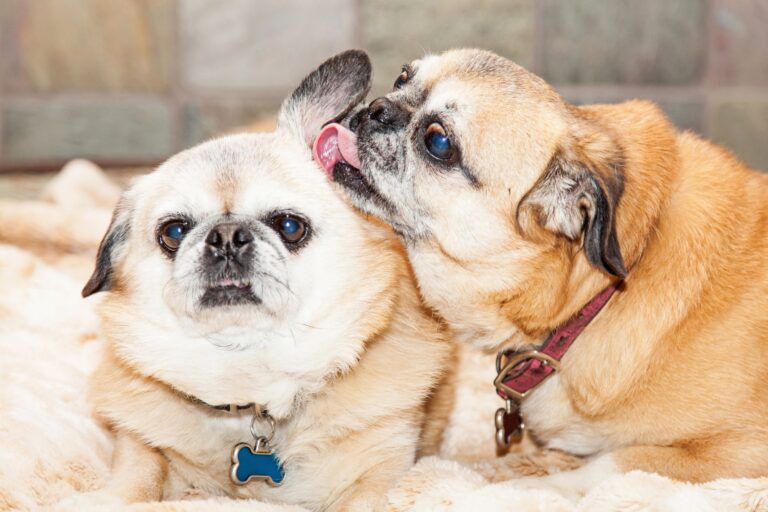Pug and Pekingese Temperament: Puginese Dog Breed
The Puginese is a delightful mix, bringing together the best features of the Pug and the Pekingese. This small yet robust dog wins hearts with deep wrinkles and soulful eyes, making it the perfect lapdog. They form strong bonds with their families due to their loving nature, always seeking affection and company.
Their coats come in various colors and need consistent grooming to stay clean and healthy. Though they don’t require a lot of exercise, Puginese dogs enjoy engaging in playful activities and relish short walks.
Owners should be aware of their potential health issues, like breathing difficulties and eye problems, and ensure they receive regular check-ups from the vet. With their small stature and flexible personality, Puginese dogs are excellent companions for apartment dwellers or those with limited space.
Key Takeaways
- Puginese dogs blend Pug and Pekingese traits for loving companions.
- Grooming their varied coat colors regularly keeps them healthy.
- Despite their small size, they should see vets for breathing and eye issues.
Quick Facts
The Puginese is a charming mix between a Pug and a Pekingese mix, known for their loving nature and compact build. These hybrids typically weigh 7 to 18 pounds and stand about 6 to 14 inches tall.
They need regular exercise to stay healthy and avoid gaining too much weight. Their coats come in various colors like cream, brown, gray, black, or brindle; expect some shedding from these pups.
Owners should closely monitor their health and schedule consistent vet check-ups to tackle issues early on.
Overview
The Puginese is a charming mix, inheriting the unique facial features and amiable nature of its Pug and Pekingese parents. This crossbreed is a thoughtful combination to bring together the best qualities of the Pug and Pekingese breeds.
It’s a small dog, making it a perfect fit for apartment living, and its friendly temperament makes it a great companion, especially for less active people such as older people.
Care for the Puginese should be attentive, especially in grooming their medium to long coats to avoid skin problems arising from their wrinkles. Owners should also be mindful of their dog’s brachycephalic face, so they must take it easy during hot weather and avoid strenuous exercise.
Puginese Pictures
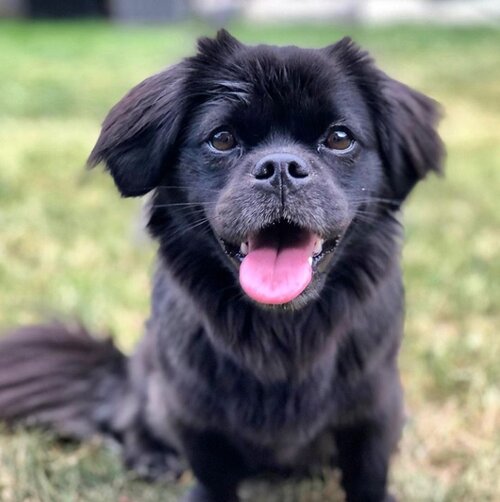
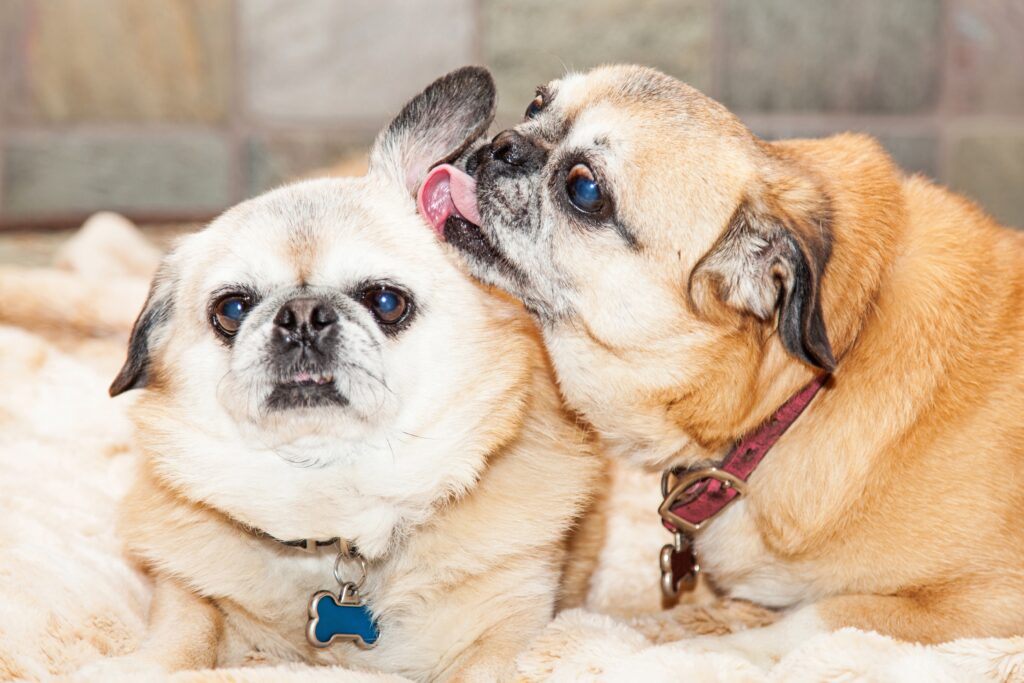
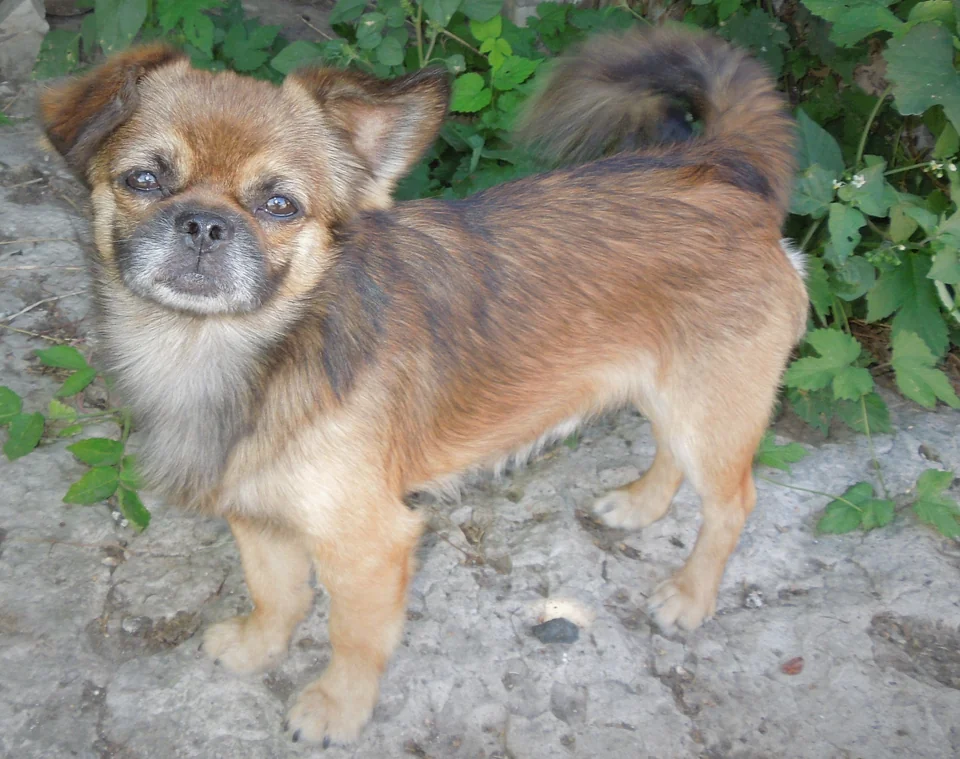
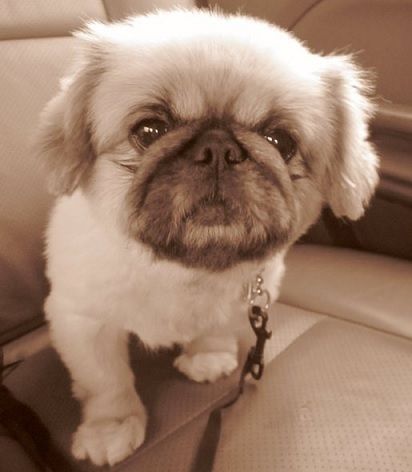

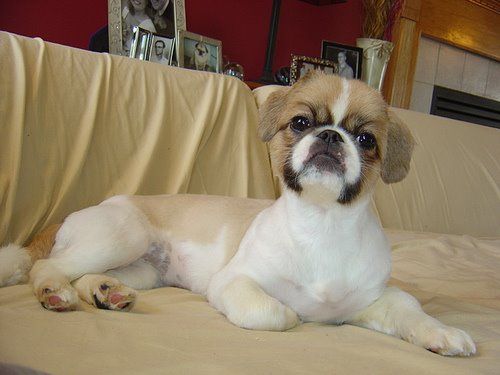
Key Traits
Puginese dogs are a designer breed that combines the qualities of Pugs and Pekingese. They’re small, sturdy pets that often become deeply attached to their families. These dogs are renowned for their devotion and affection, making them excellent companions. However, they can be pretty stubborn, so consistent training is crucial. Introducing them to various people and pets early on will help them become well-rounded adults.
Despite being suitable for different living arrangements, Puginese dogs do best in a calm environment. They have a moderate need for exercise, which matches their health profile well, as keeping active helps prevent issues related to excess weight.
Breed Origin Story
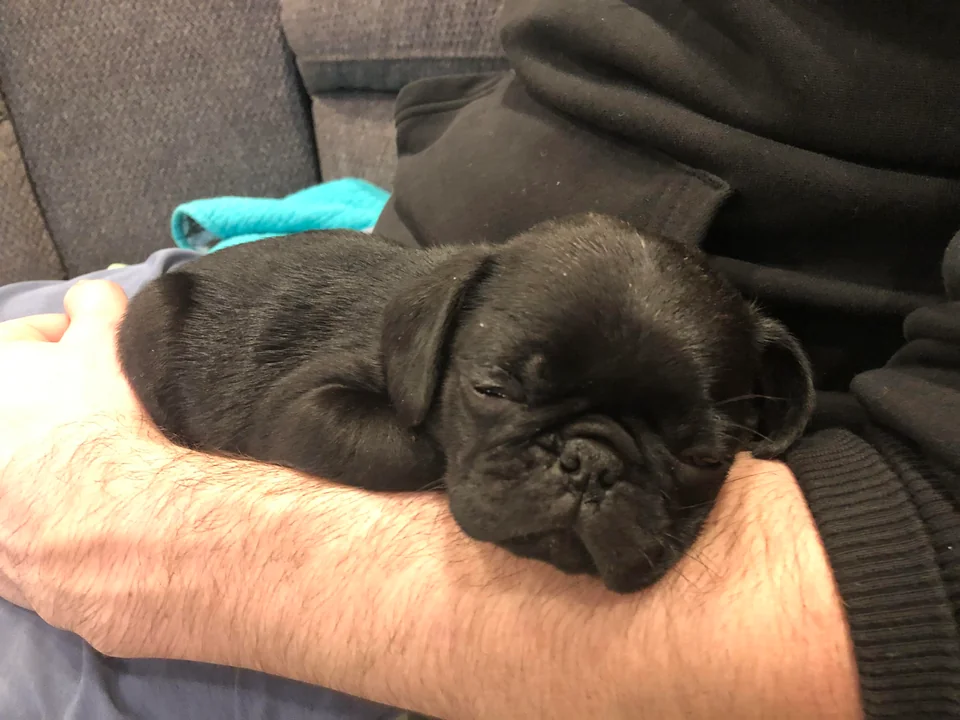
The Puginese is a modern breed that traces its lineage back to China, sprung from the intentional mix of the Pug and the Pekingese. This blending was designed to merge the best qualities of both breeds, resulting in the Puginese’s unique features.
The breed’s history has two notable parts:
Chinese Canine Ancestry
The Pug, once a favored pet in the Chinese imperial courts, and the Pekingese, regarded as a symbol of royal elegance and spiritual significance in historical dynasties, are the main contributors to the Puginese’s lineage.
Modern Breeding History
The Puginese appeared in the early 2000s, reflecting a growing fascination with designer dogs—breeders aimed to produce a companion animal with a blend of physical appeal and a pleasant demeanor.
Ancient Chinese Heritage
The Puginese, a blend of the Pug and the Pekingese, carries a remarkable heritage from ancient China. The Pug first appeared during the Han Dynasty around 200 B.C. and quickly became a symbol of prestige in Chinese history. On the other hand, the Pekingese, often called the ‘Lion Dog’ for its resemblance to the mythical Chinese guardian lions, was cherished in the imperial courts. This breed held an exclusive status as the favored companion of Chinese emperors.
The crossbreed Puginese not only combines their distinctive looks but also weaves together their rich histories. This crossbreeding has created a dog uniquely connected to China’s cultural and imperial past.
Puginese Breed Evolution
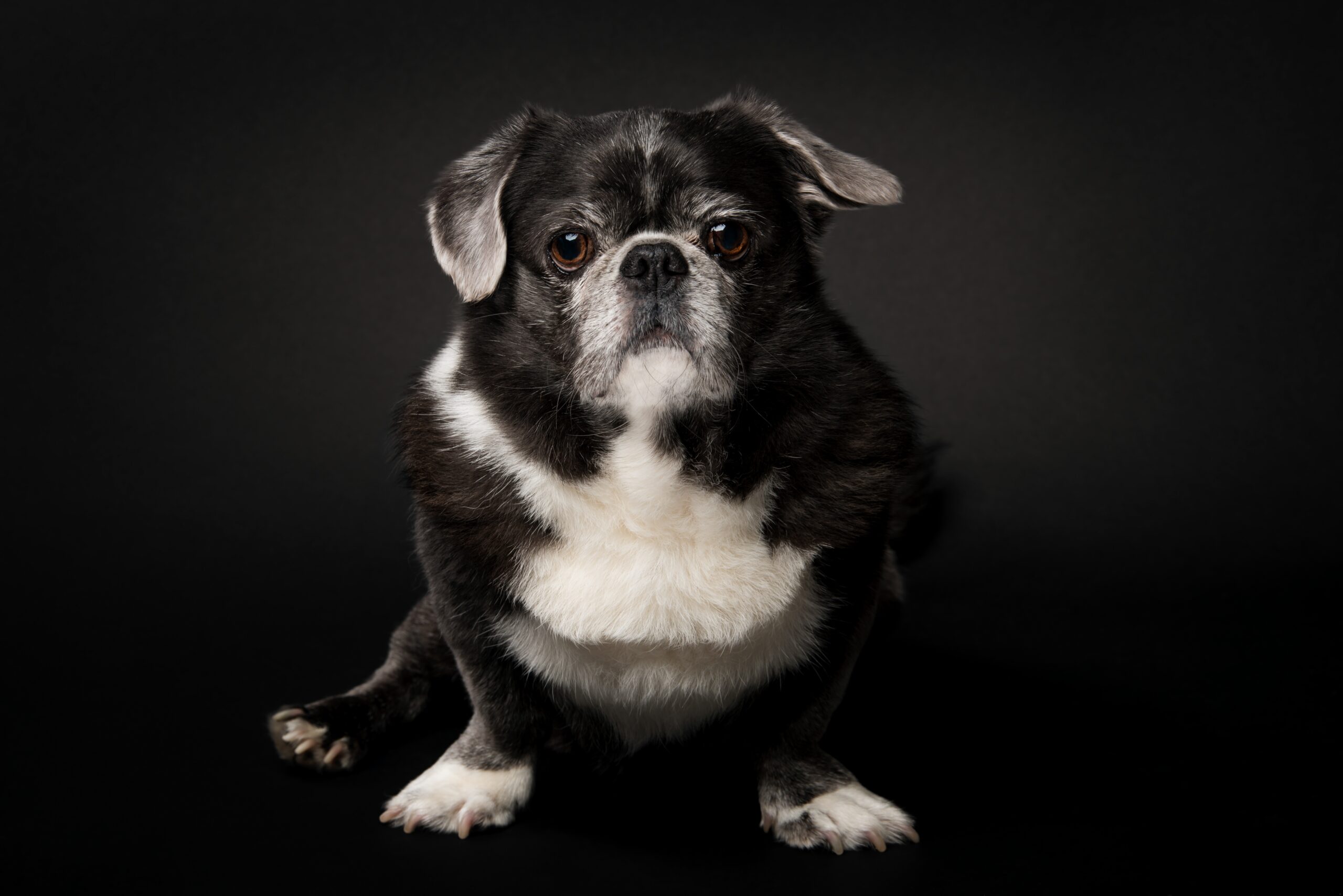
The Puginese is a charming mix that surfaced around the early 2000s, created to blend the best traits of the Pug and the Pekingese. This new breed quickly won hearts. It is designed to be small and loving, making it perfect for apartment living and companions with less space.
Selective breeding was vital to ensuring the Puginese inherited the favored characteristics of its ancestors. The breed not only carries the rich Chinese background of its parent breeds but has also become a favorite for those looking for a small, friendly pet.
The careful breeding behind the Puginese showcases the thoughtful effort to meet the needs of pet owners in today’s homes.
- Crossbreed Development History
- The Puginese is a charming hybrid breed.
- Dietary Needs
- Dietary Needs for Puginese Dogs
- Balanced Diet for Health
For Puginese dogs, a diet that includes protein, healthy fats, and complex carbohydrates from quality sources is vital. They also need a good mix of vitamins and minerals to stay healthy and avoid deficiencies.
Food for Sensitive Stomachs
It’s essential to watch for signs of food allergies or intolerances in your Puginese and choose dog food that doesn’t contain those triggers. Look for dog foods for sensitive stomachs if your pet has digestive issues.
Managing Food Portions
To keep your Puginese at a healthy weight, it’s critical to measure their food and keep track of calories. The right amount of food will depend on their age, weight, and activity, so adjust as needed.
Balanced Nutrition Importance
Feeding your Puginese dog the right food is essential for keeping them healthy and happy. These little dogs can gain weight quickly, which can lead to diabetes and other health problems. That’s why it’s so important to get their diet just right.
A balanced diet supports their immune system, which is crucial since they can be prone to respiratory issues and allergies. A well-planned meal routine also helps maintain a strong heart, which is essential for dogs that might face heart murmurs and keeps their joints healthy to prevent issues like a slipping kneecap.
Their skin and coat will benefit from the right mix of nutrients, helping to avoid irritation and keep them looking their best. Always consult a vet to create a diet that meets your Puginese’s needs.
Allergy-Sensitive Food Choices
Puginese dogs, with their charming mix of Pug and Pekingese traits, also inherit a tendency for dietary sensitivities. Owners should be vigilant about their pet’s food choices to prevent allergic reactions.
Recognized by canine organizations like the International Designer Canine Registry and the Designer Dogs Kennel Club, the Puginese breed’s nutritional needs are well-documented. These groups stress the importance of feeding them a high-quality diet free from common allergens and artificial additives.
For Puginese pups, avoiding ingredients that often cause allergies, such as chicken and oatmeal, is a smart move. Instead, it is advisable to incorporate a hypoallergenic dry food precisely portioned to meet their unique health requirements.
The American Canine Hybrid Club and the Dog Registry of America highlight the breed’s need for specialized diets, so consulting with a vet about a personalized feeding plan is beneficial for maintaining their well-being.
Portion Control Tips
Portion control is vital for Puginese dogs, a breed known for its susceptibility to obesity and diabetes. Originating from a Pug parent, Puginese dogs tend to gain weight quickly, so their diet must be carefully managed.
To keep a Puginese healthy, use measuring tools to serve precise portions and follow the American Kennel Club’s recommended feeding guidelines. When a Puginese becomes part of your family, create a feeding plan that considers the dog’s age, weight, and activity level, and adjust food amounts to avoid overfeeding.
Keep a close eye on their diet, making necessary changes to help prevent health issues related to their tendency to become overweight or diabetic.
Additional Information: About the Puginese Dog Breed

The Puginese, often called a “designer breed,” originated from the crossbreeding of the Pug and Pekingese, likely in the United States. While the exact inception date is unknown, the desire to combine the affectionate nature of the Pug with the regal elegance of the Pekingese led to the development of this mixed breed. The unique ancestry of the Puginese contributes to its distinctive personality and physical traits.
Physical Characteristics of Puginese
The Puginese generally displays a combination of traits from both parent breeds. They are small-sized dogs with a sturdy build, and their distinct appearance often includes a wrinkled forehead, a short muzzle, and dark, expressive eyes. Their coat can vary in color and texture, featuring a mix of the Pug’s smooth, short fur and the Pekingese’s longer, flowing hair. This combination creates a charming and unique look that distinguishes the Puginese from other dog breeds.
Personality and Temperament
The temperament of the Puginese embodies the best qualities of both the Pug and Pekingese. They are affectionate, playful, and known for their loyalty to their owners. Puginese dogs are often described as companionable and make excellent family pets due to their adaptability and friendly nature. While they may inherit the watchdog instincts from their Pekingese parent, they are also social dogs that enjoy being around people and other pets.
Training and Socialization Needs
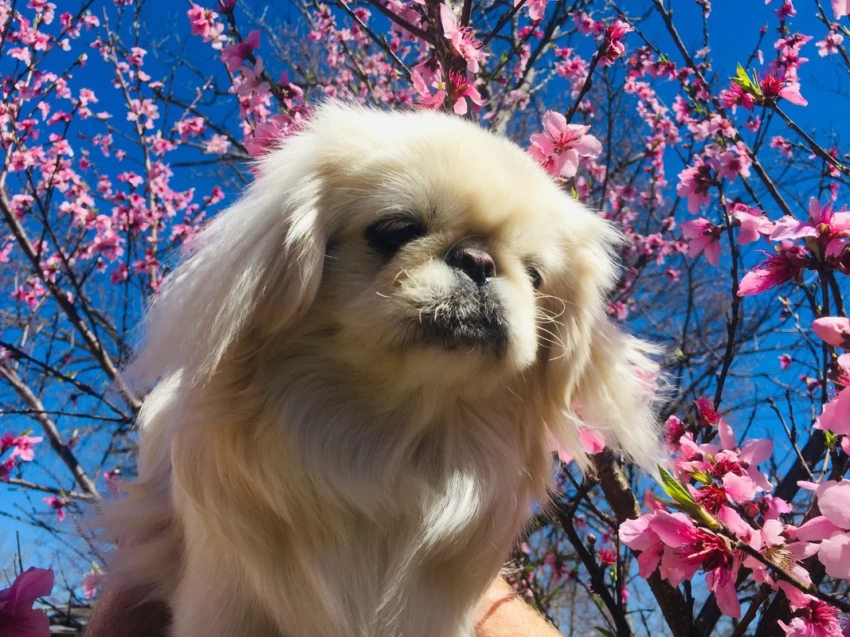
Proper training and early socialization are essential for Puginese puppies to ensure they grow up to be well-behaved and confident dogs. Positive reinforcement techniques benefit their obedience training, helping them understand commands and develop good manners. Additionally, exposing them to various environments and different people during the socialization period is crucial to prevent any potential behavioral issues in the future.
Grooming and Health Care for Puginese
Grooming requirements for Puginese dogs generally include regular brushing to maintain their coat and prevent matting. Bathing should be done when necessary, using a mild dog shampoo to keep their skin healthy. As with all dog breeds, routine veterinary check-ups, vaccinations, and dental care are essential for their well-being. Puginese, like many small breeds, may be prone to dental issues, so regular teeth brushing is crucial to prevent dental problems.
Exercise and Activity Requirements
Despite their small size, Puginese dogs have moderate energy levels and require regular exercise to stay healthy and happy. Daily walks and playtime are beneficial for them to expel their energy and engage in mental stimulation. However, it is essential to avoid excessive strenuous activities due to their relatively delicate build. As with any dog, engaging in enriching activities strengthens the bond between the owner and their Puginese companion both physically and emotionally.
Adopting a Puginese: What You Need to Know
Finding a Reputable Puginese Breeder
When seeking to adopt a Puginese, it is crucial to find a reputable breeder who prioritizes the health and welfare of their dogs. Responsible breeders ensure proper care, socialization, and health screening of the parent breeds, thereby minimizing the risk of hereditary health issues in the puppies. Conducting thorough research and visiting the breeder’s facility can provide valuable insights into their breeding practices and the well-being of the dogs.
Considerations for Apartment Living with a Puginese
The Puginese’s adaptability and small size make them well-suited for apartment living, provided they receive sufficient exercise and mental stimulation. Their moderate exercise requirements and affectionate nature make them excellent companions for individuals living in urban settings. However, potential owners should be mindful of providing adequate opportunities for exercise and playtime, even within a smaller living space.
Introducing a Puginese to Your Family and Other Pets
Patience and gradual introductions are key when introducing a Puginese to a new environment or other pets. As social animals, Puginese dogs generally adapt well to new family members and pets, given the proper introduction and socialization. Supervising initial interactions and providing positive reinforcement is essential to ensure a harmonious relationship within the household.
Puginese: Common Health Issues and Care Tips
Understanding Puginese Health Concerns
Like all dog breeds, Puginese may be susceptible to specific health issues inherited from their parent breeds. Potential health concerns for the Puginese may include respiratory problems due to their flat faces, dental issues, skin conditions, and orthopedic problems such as hip dysplasia. Regular veterinary check-ups and a well-balanced diet can aid in maintaining their overall health and well-being.
Tips for Maintaining Puginese’s Well-being
Providing a nutritious diet, regular exercise, and preventative healthcare is essential for maintaining the well-being of the Puginese. As with any dog, a balanced diet tailored to their size and activity level and regular grooming aids in preventing common health issues. Maintaining a healthy weight through proper portion control and regular exercise can help prevent obesity-related health concerns.
Recognizing Signs of Stress or Health Problems
Owners should observe changes in their Puginese’s behavior, appetite, or physical condition, as they can indicate underlying health issues or stress. Timely veterinary intervention is crucial if any concerning symptoms arise. Understanding the typical signs of distress or discomfort in dogs will assist owners in ensuring the overall well-being and happiness of their Puginese companion.
Fun Facts and Notable Traits of the Puginese
Personality Traits from Pug and Pekingese Ancestry
Combining the affectionate, playful nature of the Pug with the regal, loyal traits of the Pekingese, the Puginese inherits a delightful array of personality traits from both parent breeds. They are known for their endearing companionship and aptitude as family pets, providing unwavering loyalty and affection to their owners.
Unique Characteristics of Puginese as a Mixed Breed
As a mixed breed, the Puginese exhibits a distinctive appearance and temperament that sets them apart from purebred dogs. Their individuality stems from the combination of traits inherited from the Pug and Pekingese, resulting in a charming and affectionate companion that appeals to many dog enthusiasts.
Why Puginese Make Great Companions for Families
Puginese dogs are well-suited family companions due to their adaptable nature, affectionate disposition, and compatibility with children and other pets. Their moderate exercise needs and loving and playful personality make them a perfect addition to households seeking an engaging and devoted family pet.
In China in the early 2000s, it was formed by carefully breeding Pugs with Pekingese. This breed was designed to inherit the best traits of its parent breeds, resulting in a small yet spirited companion.
Although the Puginese have only been around for about twenty years, they have earned recognition from organizations like the American Canine Hybrid Club. Variations in their looks and behavior can be expected due to the mixed genetic contributions of the Pug and Pekingese.
The creation of the Puginese is a testament to modern selective breeding efforts focusing on developing pets with specific traits.
Physical Dimensions
Physical Traits of the Puginese Dog
The Puginese dog breed comes in various sizes, which is crucial to understanding their health needs. When you look at their average size, adult Puginese typically weigh between 7 and 18 pounds. Due to their tendency to gain weight, monitoring their diet and ensuring they get enough exercise is vital.
As for their height, they stand about 6 to 14 inches tall at the shoulder. This height range can impact their mobility and their agility during activities.
Average Adult Size
Puginese dogs are a small mixed breed that can be anywhere from 6 to 14 inches tall and weigh between 7 to 18 pounds. There’s quite a bit of size variation in these dogs, and you might come across some larger or smaller than these figures.
If you live in a smaller space like an apartment, a Puginese could be the perfect fit because they don’t take up much room. They are also a good match for a laid-back lifestyle since they don’t require a lot of exercise.
It’s worth noting that their small stature comes with an increased risk of specific heritage health issues, such as breathing and eye problems, which should be watched closely.
Weight Range
Puginese dogs, a cross between Pugs and Pekingese, weigh 7 to 18 pounds. Their small stature is perfect for apartment living, but owners should watch their diet and exercise to avoid health issues like obesity and diabetes.
Keeping an eye on their weight is essential, as these adorable dogs can face serious health problems if they become overweight. A healthy lifestyle, including regular vet check-ups and a balanced diet, will help keep your Puginese happy and active.
Height at Shoulders
Puginese, a mix of Pug and Pekingese breeds, typically have a shoulder height ranging from 6 to 14 inches. Their size places them in the small to medium dog category, but don’t let their size fool you; these dogs are often full of energy.
It’s worth noting that Puginese may be more prone to certain eye conditions due to their distinctive facial structure, which they inherit from their parent breeds. Prospective owners should consider these health aspects before adopting one of these lively companions.
Body Length
Puginese dogs, a crossbreed of Pekingese and Pugs, typically measure 12 to 16 inches long. These dogs present a well-proportioned figure that aligns with their height, ensuring a sturdy and well-balanced appearance.
Puginese owners should prepare for an entirely hands-on grooming routine, especially if their pet has a coat that sheds frequently. Regular brushing keeps them looking good and promotes healthier skin by removing loose fur.
Considering their size, Puginese dogs require a thoughtful mix of exercise and diet to stay healthy and in shape.
Growth Patterns
Knowing how your Puginese dog grows from a puppy into an adult helps you plan for their changing size and needs. Puginese pups proliferate, often reaching most of their adult size early. This early stage lays the groundwork for their long-term health, so keeping an eye on their growth can clue you into any health problems.
Daily walks are crucial to controlling weight since Puginese can quickly become overweight. This extra weight can lead to breathing problems and other health issues. A good diet and exercise routine will help your Puginese grow up healthy and maintain the correct size.
Behavioral Traits
Understanding Puginese Dogs’ Behavior
When looking at the behavior of Puginese dogs, it’s vital to recognize their temperament can vary. Some may be calm and loving around their human families, while others might be more lively, demanding activities to keep them engaged.
For these dogs, proper socialization and training are essential. Introducing them to new experiences early helps prevent shyness. They may show a stubborn streak during training, so persistence and positive reinforcement are necessary.
Temperament Variation
The Puginese, a mixed breed dog, can range from being independent to being extra attentive to their owners. They are often eager to learn, which makes training them smoother and helps them fit well into different home settings. However, some Puginese may show a stubborn streak, likely a trait passed down from their Pug and Pekingese heritage, making teaching them obedience a bit more challenging.
Introducing them to various people and pets early on is critical to developing their social skills and preventing unwanted behaviors. A well-socialized Puginese usually enjoys the company of other animals and is friendly towards new people they meet.
These dogs balance their loyalty and love for attention with moments where they prefer to be alone, and their genes and upbringing can influence this balance.
Socialization Needs
Socializing your Puginese is essential for their growth, helping them get along well with people and other pets. Positive reinforcement methods work best to teach them good manners. Start preparing your Puginese while they’re young to reduce shyness around new faces or dogs. Consistent and patient obedience training can help manage their stubborn streak.
When introduced slowly and friendly, puginese dogs can learn to live harmoniously with different animals. Taking them to various social settings can also improve their reactions to new people and places. This exposure helps them become well-adjusted and less stressed when encountering new situations.
Training Challenges
Training a Puginese, known for their affectionate yet stubborn qualities, can be quite a task. These dogs often show a strong will and are resistant to following instructions, which means trainers must use consistent rewards and praise to encourage them.
Although they aim to please their owners, Puginese can be slow to pick up new commands, so patience and repetitive teaching are key. Their activity levels aren’t typically high, but they still benefit from a balanced mix of engaging their minds and keeping them physically active during training.
Also, because they tend to shed and need regular grooming, you should consider these factors when planning their training schedule to keep them focused and comfortable.
Activity Levels
Puginese dogs typically prefer a more relaxed lifestyle, needing only moderate exercise to stay healthy. Taking them on a daily walk usually covers their physical needs, as they don’t crave intense workouts.
Interactive play sessions, like a game of fetch, can keep them mentally and physically sharp without wearing them out. Monitoring how much they move daily is vital to keep them in good shape and prevent weight gain, a risk for less active breeds.
The right amount of exercise is vital to keeping your Puginese happy and healthy.
Compatibility With Pets
Compatibility With Pets
When introducing a Puginese to other animals in your home, it’s essential to understand their unique personality traits. These dogs are known for their friendly nature, often making them good companions for other pets. However, they can sometimes be stubborn, which might lead them to prefer being the only dog around.
To help them get along with other animals, start socializing them early. This helps reduce any hesitation they might feel towards new creatures. Though Puginese typically don’t have a strong instinct to chase, careful and gradual introductions are crucial. Pair this with ongoing training and rewards for good behavior to help all your pets live together harmoniously.
Health Concerns & Management
Health Concerns & Management
Caring for the health of Puginese dogs means paying close attention to their unique needs. Proactive measures and consistent check-ups help maintain their well-being. Understanding how to prevent breathing difficulties, the value of regular vet visits, and designing a diet for a healthy life are all essential for Puginese owners.
Breathing Problem Prevention
Understanding and managing the risks of brachycephalic syndrome is vital for these dogs. Creating a living environment that minimizes respiratory stress helps keep them comfortable.
Regular Health Check-Ups
Catching potential inherited health issues early on can make a big difference. Monitoring their weight and joint health is essential to prevent future problems.
Diet for Longevity
A diet that meets their specific energy needs can help Puginese dogs live longer, healthier lives. Monitoring their food intake to prevent obesity is also crucial for their health.
Breathing Problem Prevention
For Puginese dog owners, taking steps to prevent breathing problems is vital to keeping your pet healthy. Regular visits to the vet for check-ups can catch any potential issues early on.
It’s also wise to manage their environment carefully; keep them cool during hot weather to avoid heat stress.
Ensure your Puginese maintain a healthy weight to ease the burden on their respiratory system. Watch their activity levels, making sure they get enough exercise without overdoing it.
Regular grooming, especially cleaning around their facial folds, will help prevent infections that can lead to breathing issues.
Check with your vet for advice about your dog’s needs to prevent respiratory problems and maintain their well-being.
Regular Health Check-Ups
Regular health check-ups are vital for Puginese dogs due to their vulnerability to health issues like heart murmurs and diabetes. These visits are crucial to catching problems early, leading to quicker treatment and better chances of recovery. Vets perform detailed exams that can detect early signs of respiratory problems or the development of inherited conditions such as epilepsy and a dislocating kneecap.
Including a weekly brushing session in your Puginese’s grooming routine helps prevent the buildup of loose fur, which can cause skin allergies and increase the risk of overheating. Paying close attention to dental care is also paramount; frequent teeth cleanings help ward off dental diseases, supporting the dog’s overall health.
Sticking to a regular schedule of health assessments reassures owners and helps ensure the long-term health of their Puginese.
Diet for Longevity
Puginese dogs need a carefully crafted diet to help them avoid weight gain and diabetes, which are critical to their long-term health. Choosing natural and minimally processed foods can protect your Puginese from potential health issues related to allergies and artificial ingredients.
Custom-made dog food that meets their specific nutritional needs is vital for maintaining a healthy metabolism and preventing obesity, a common problem in these dogs.
Regular check-ups with the vet are essential to keep their diet in line with their changing health needs, ensuring they live a long and happy life.
Maintenance & Upkeep
Caring for Puginese dogs involves vital routines that significantly impact their health and happiness. These dogs benefit from a thoughtful care plan, which includes regular grooming, a balanced diet to avoid weight issues, and sufficient exercise to keep them in good shape.
Grooming Practices
It’s best to brush your Puginese weekly to control shedding and keep their coat healthy. For their sensitive skin, opt for gentle, hypoallergenic shampoos and conditioners.
Health Monitoring
Visiting the vet twice a year helps catch any health problems early, especially for those familiar with the breed. Keeping an eye on their weight is vital as these dogs can be prone to obesity and diabetes if not appropriately managed.
Grooming Frequency
Grooming a Puginese involves brushing their coat once a week to reduce shedding and keep their skin healthy. Their coat length and color can vary, affecting how often they must be groomed. Brushing removes dead hair, prevents tangles, and spreads the dog’s natural oils, giving their coat a lustrous appearance.
If your Puginese has sensitive skin, it’s a good idea to use grooming products designed to prevent irritation. Cleaning their unique facial wrinkles with a soft wipe is crucial for avoiding infections.
In hot weather, a shorter haircut can help make grooming more manageable and keep your dog cool, especially since Puginese struggles with heat due to their breathing.
Exercise Requirements
Exercise is vital for Puginese dogs with moderate activity needs but low stamina. A short daily walk is typically enough to keep them healthy and happy. Their short-nosed facial structure requires a careful approach to physical activity to prevent breathing issues.
People living in apartments will often find the Puginese a perfect match since they thrive indoors and don’t need much room for daily exercise. Still, it’s wise to remember these dogs can be sensitive to loud noises, which might bother them when outside.
A well-planned exercise routine is vital for a Puginese’s well-being, ensuring they stay active without getting worn out.
Diet Considerations
Puginese dogs need a well-balanced diet to avoid health issues like obesity and diabetes. Choose premium dry food made for small breeds to meet their nutritional needs without causing weight gain. A daily portion of about ¾ cup split into several meals, helps maintain steady energy levels and a healthy metabolism.
During hotter months, keep an eye on their food intake. Activity levels often drop, so adjusting their food can prevent putting on extra pounds. Regular check-ups with a vet and a thoughtful feeding plan are vital to keeping your Puginese in top shape.
Health Check Routines
A balanced diet plays a significant role in preventing obesity and diabetes in Puginese dogs. Yet, it’s just as vital to establish a routine of regular health checks to ensure their well-being and long life.
These health assessments, set up with your vet’s guidance, should look for breed-specific issues like heart murmurs, breathing problems, and epilepsy indicators.
Due to their sensitive skin, Puginese dogs also need special grooming attention. This includes using hypoallergenic shampoos and carefully cleaning their facial wrinkles to prevent infections.
The Designer Breed Registry advises regular grooming to remove dead fur and keep their skin in good condition. Clipping their coats can be particularly helpful to keep them cool in hot weather.
These consistent health and grooming habits are vital to properly caring for your Puginese dog.
Training Commitment
Training a Puginese dog requires a solid commitment to consistent, positive training methods to keep them healthy and well-behaved. Owners must understand that Puginese dogs are charming companions, but they need a thoughtful approach to training that considers patience and their distinctive character.
Any dog owner must realize that choosing the right dog involves a particular responsibility. It’s essential to ensure that your training efforts match the specific needs of a Puginese. These dogs do best with a structured daily schedule, mental challenges, and physical activity tailored to their more laid-back energy level.
Keeping an eye on their training progress and making necessary tweaks to their routine is vital to keep them content and healthy.

